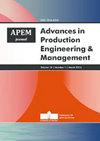在NaCl溶液中盐雾试验后铬合金碳钢试样的表面特征
IF 2.8
3区 工程技术
Q2 ENGINEERING, MANUFACTURING
引用次数: 1
摘要
最常见的腐蚀测试程序使用由给定钢材料制作的平面测试片。然而,经过加工和精加工的工件,特别是那些具有复杂几何形状的工件,可能更容易在其曲面上发生表面退化。从长远来看,这可能会对测试组件的平稳运行产生不利影响。本研究探讨了具有相当复杂几何形状的铬合金钢机加工和精加工试样的表面特征。在35°C的化学腐蚀性介质(含水NaCl喷雾)中,周期性地(在24、96和192小时后)测量了几组制造的碳钢行星轴规格的几个重要表面特征(形貌、粗糙度、圆柱度、化学降解率和腐蚀产物)的变化。在中性盐雾(NSS)试验柜中,铬合金碳钢轴的圆柱形部分表现出相当严重和不均匀的化学降解,形成了几种氧化铁-氢氧化铁产物(铁锈)和一些铬化合物。在仔细去除相对松散的腐蚀产物后,暴露的裸露轴表面的几何变化显示出在整个腐蚀测试期间粗糙度值的稳定(接近线性)增加。这种化学攻击也引起了表面形貌的显著变化。结果表明,24小时试验后粗糙度参数的平均值约为原始值的2.5倍,而在96小时试验中粗糙度参数的平均值增加了4倍,在192小时试验中粗糙度参数的平均值增加了约8倍。此外,发现腐蚀表面的三维粗糙度参数(Sa, Sz, Sq)平均是其二维参数(Ra, Rz, Rq)的两倍。圆度和圆度误差数据显示,随着盐雾试验时间的延长,圆度和圆度误差也有类似的增加。©2019马里博尔大学CPE。版权所有。本文章由计算机程序翻译,如有差异,请以英文原文为准。
Surface features of chromium alloyed carbon steel specimens after salt-spray tests in NaCl solution
The most common corrosion testing procedures use flat test coupons fabri‐ cated from a given steel material. However, workpieces that undergo machin‐ ing and finishing, especially those with complex geometry, may be more sub‐ ject to surface degradation on their curved surfaces. In the long run, this may adversely affect the smooth operation of the tested component. This study investigates surface features of machined and finished chromium alloyed steel specimens with rather complex geometries. Changes in several important surface features (topography, roughness, cylindricity, chemical degradation rate and corrosion products) were all measured periodically (after 24, 96 and 192 hours) on several sets of manufactured carbon steel planetary axle spec‐ imens exposed to a chemically aggressive medium (aqueous NaCl spray) at 35 °C. In the neutral salt spray (NSS) testing cabinet the cylindrical parts of the chromium alloyed carbon steel shafts showed quite severe and uneven chemical degradation, with the formation of several iron oxide‐hydroxide products (rust) observed together with some chromium compounds. After careful removal of the relatively loose corrosion products, the exposed bare shaft surface’s geometrical changes showed steady (close to linear) increase in the roughness values throughout the duration of the corrosion tests. This chemical attack caused significant changes in the surface topography as well. It was found that the average values of roughness parameters after the 24‐ hour test were about two and a half times higher than the original values, while they increased by four‐fold in the 96‐hour test and by approximately eightfold in the 192‐hour test. Furthermore, it was found that the values of the 3D roughness parameters (Sa, Sz, Sq) are on average twice that of their 2D counterparts (Ra, Rz, Rq) on the corroded surfaces. Circularity and roundness error data showed a similar increase with salt‐spray test time duration. © 2019 CPE, University of Maribor. All rights reserved.
求助全文
通过发布文献求助,成功后即可免费获取论文全文。
去求助
来源期刊

Advances in Production Engineering & Management
ENGINEERING, MANUFACTURINGMATERIALS SCIENC-MATERIALS SCIENCE, MULTIDISCIPLINARY
CiteScore
5.90
自引率
22.20%
发文量
19
期刊介绍:
Advances in Production Engineering & Management (APEM journal) is an interdisciplinary international academic journal published quarterly. The main goal of the APEM journal is to present original, high quality, theoretical and application-oriented research developments in all areas of production engineering and production management to a broad audience of academics and practitioners. In order to bridge the gap between theory and practice, applications based on advanced theory and case studies are particularly welcome. For theoretical papers, their originality and research contributions are the main factors in the evaluation process. General approaches, formalisms, algorithms or techniques should be illustrated with significant applications that demonstrate their applicability to real-world problems. Please note the APEM journal is not intended especially for studying problems in the finance, economics, business, and bank sectors even though the methodology in the paper is quality/project management oriented. Therefore, the papers should include a substantial level of engineering issues in the field of manufacturing engineering.
 求助内容:
求助内容: 应助结果提醒方式:
应助结果提醒方式:


